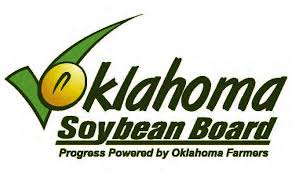oKLAHOMA rESEARCH
Making the Most of Every Season
From adverse weather to pest and disease infestation, soybean farmers face new challenges in their fields each season. To address these challenges, the farmer-led soybean checkoff invests funding in production research that maintains and improves yields.
Multi-Tiered Approach
Soybean checkoff-funded production research occurs at state, regional and national levels. To increase efficiency, the soybean checkoff funds projects and meetings that promote synergy and communication in the research community. Research coordination leverages checkoff investments and provides opportunities to establish research projects and priorities across the entire soybean industry.
Improving Oklahoma Production
As Oklahoma soybean farmers, the directors of the Oklahoma Soybean Board understand production challenges unique to the state, and the board works to address those challenges. By partnering with researchers at Oklahoma State University, the checkoff works to improve soybean production practices, including seeding rates, insecticide and fungicide applications and tilling methods.
National Success
At the national level, the United Soybean Board farmer-leaders invest checkoff funding in production research programs on behalf of all U.S. farmers. The research aims to increase yields by combating yield-robbers like SCN, aphids, rust and drought, and to add value to U.S. soybean production by improving soybean composition to meet customer needs. The soybean checkoff also invests in soybean genomics research to aid in breeding for both disease resistance and composition improvements.
The soybean checkoff funds research and creates tools to help producers identify, manage and defend soybean fields from yield-robbing diseases and pests.
Weed Management in Oklahoma Soybeans
Todd Baughman (Oklahoma State University); ($24,100).
Weeds are a major production concern for soybean producers throughout the state of Oklahoma.Weeds compete with the soybean crop for sunlight, moisture, and nutrients throughout the growing season. Weed management programs are based on the weed species present, however, other factors such as soil type, pH, organic matter, and rotational crops must all be considered when making a herbicide recommendation.
The introduction of Roundup-Ready technology revolutionized weed control in many crops including soybean. Due to the relative effectiveness and simplicity of this system has led many growers to rely solely on glyphosate as the only herbicide used in their soybean production system. Herbicide resistance to glyphosate has reduced the effectiveness of this system for many growers. Therefore, other weed management systems either alone or in combination with Roundup-Ready systems must be evaluated to determine systems that are both efficacious and economical.
Project Objectives:
Investigate weed management practices that effectively and economically control weeds important to Oklahoma soybean farmers;
Investigate the use of residual weed management systems including both preemergence and postemergence residual herbicides in conjunction with glyphosate;
Develop weed management systems that will most effectively control weeds but also protect the future utility of this technology; and
Use the results developed from these studies in Extension presentations and publications.
Increasing Soybean Yields with the Utilization of Starter Fertilizers
D. Brian Arnall (Oklahoma State University); ($11,148)
The soybean producers in Oklahoma are requesting specific recommendations for the use of both traditional starter fertilizers (ammonium poly phosphate) and products being popularly advertised. At this time university extension professionals are reliant upon research performed in other states that may, or may not, reflect the specific conditions of Oklahoma soybean production. This study provides field demonstrations, field day tours and educational materials that clarify nutrient management strategies important to soybean production in Oklahoma.
Project Objectives:
Identify starter fertilizer management practices that will increase soybean yields while minimizing nutrient inputs;
Develop specific starter fertilizer recommendations for soybean production in Oklahoma; and
Organize field days and plots tours that reflect the research efforts and conclusions.
Disease and Yield Responses of Soybeans to Seed Treatments
John Damicone (Oklahoma State University); ($21,378).
Soybeans and wheat are two crops grown that do not normally include seed treatment with fungicide to control seedling disease (seed rot and damping off). Stand establishment is a problem in many soybean fields. In particular, stands appear to be more erratic in the production of full-season soybeans planted in June and July. Seedling diseases caused by the fungi Fusarium, Rhizoctonia, and Pythium may be involved in stand establishment when conditions are not ideal for germination and emergence. There are species of Pythium that are most damaging at high soil temperatures. The evaluation of seed treatments at various planting dates and under different tillage regimes may provide growers useful information for maximizing stand establishment and yield potential.
The soybean cyst nematode (SCN) is the most serious soybean pest in the United States. While soybeans can be produced in SCN-infested fields, up to 30% yield losses can occur without obvious symptoms. Therefore farmers usually do not know that their fields are infested with SCN. SCN is known to occur in 11 counties in eastern Oklahoma. Soybean varieties with various sources of resistance are available. Seed treatment nematicides are also available that may increase yields in infested fields. The ultimate goal of this project is to update soybean production management recommendations that reduce seedling disease and pest concern to Oklahoma soybean producers.
Project Objectives:
Evaluate seed treatments on soybean stand and yield responses for various planting dates in fields with and without soybean cyst nematodes. Seed treatments will include several fungicides and/or insecticide seed treatments combinations (Captan, Thiram, Evergol Energy, Apron Max, Gaucho, Cruiser & Cruiser Maxx);
Conduct SCN management trials comparing sources of SCN resistances (PI88788, Peking, and Hartwig) with seed treatments (Avicta & Poncho Votivo); and
Report results to soybean producers at production meetings and on the internet




